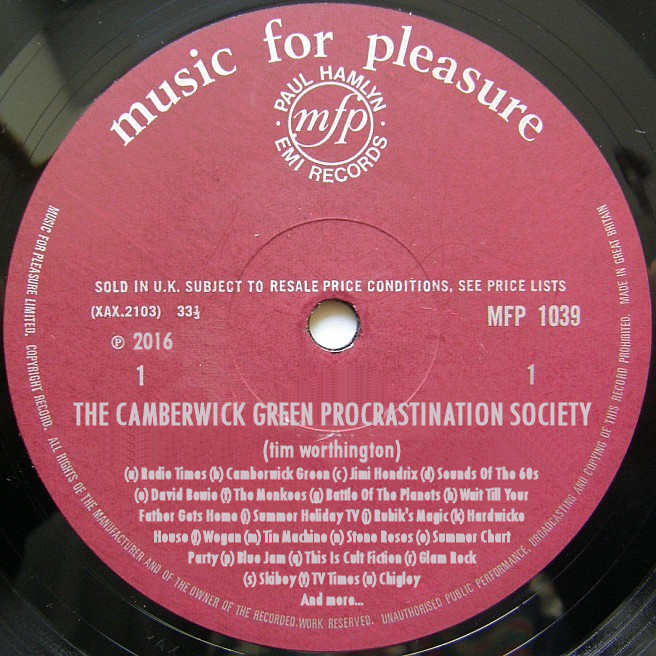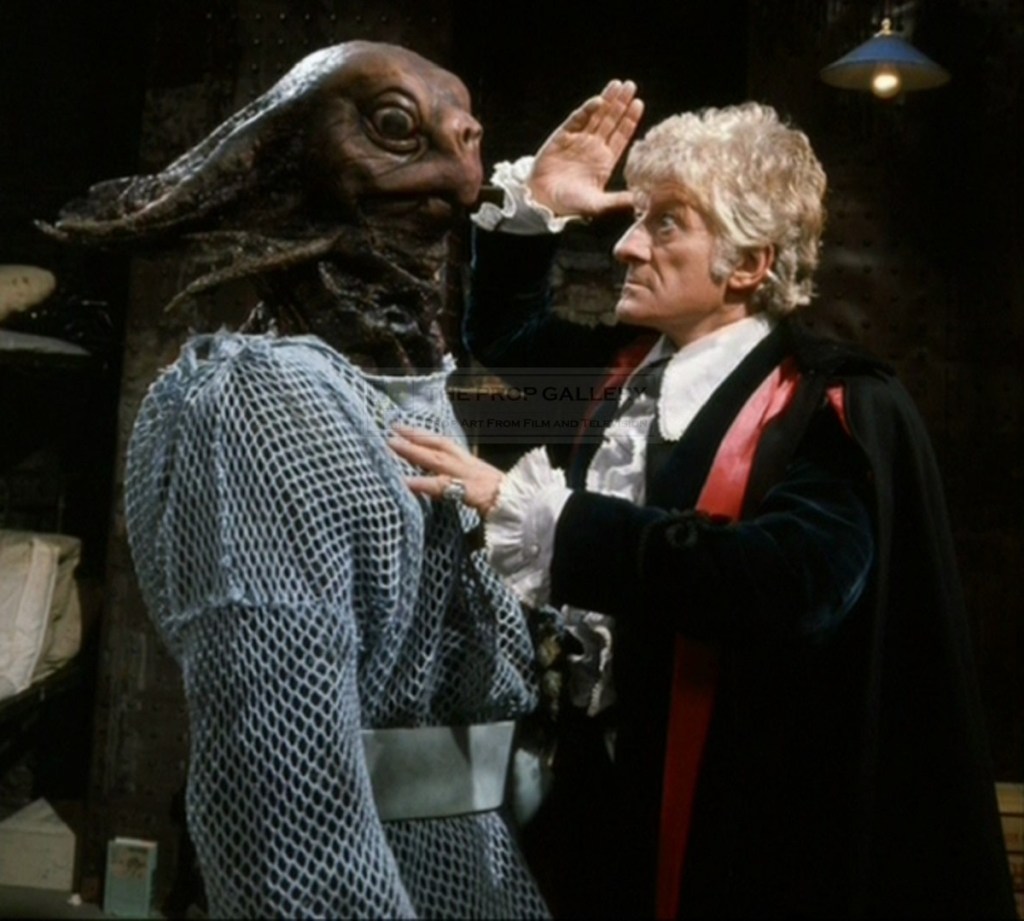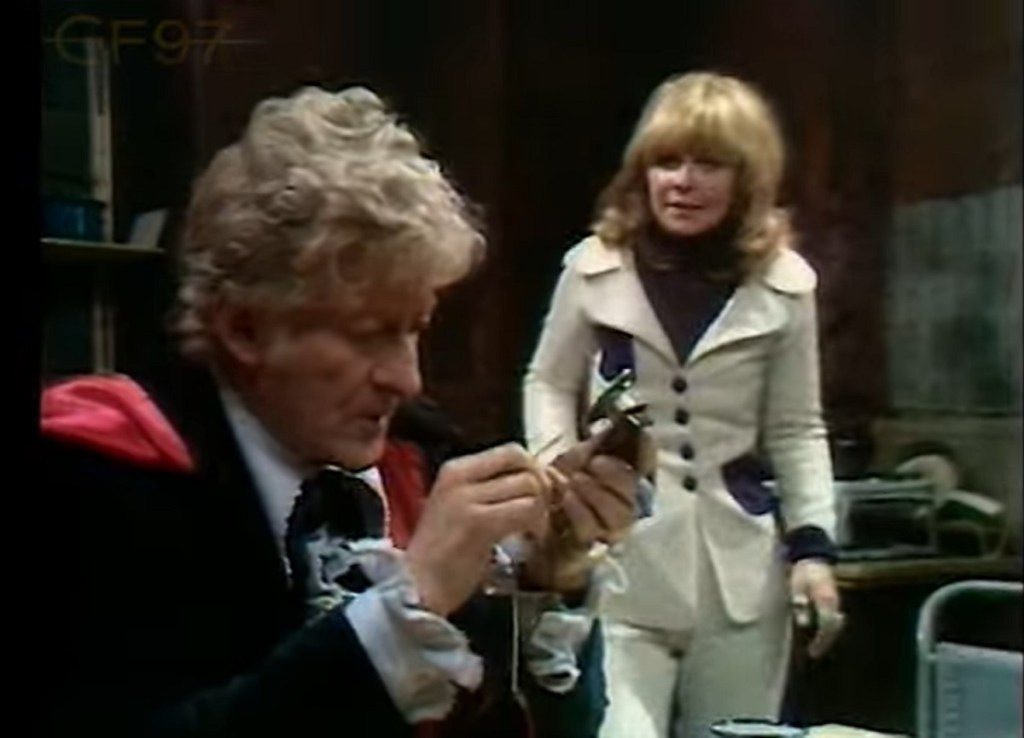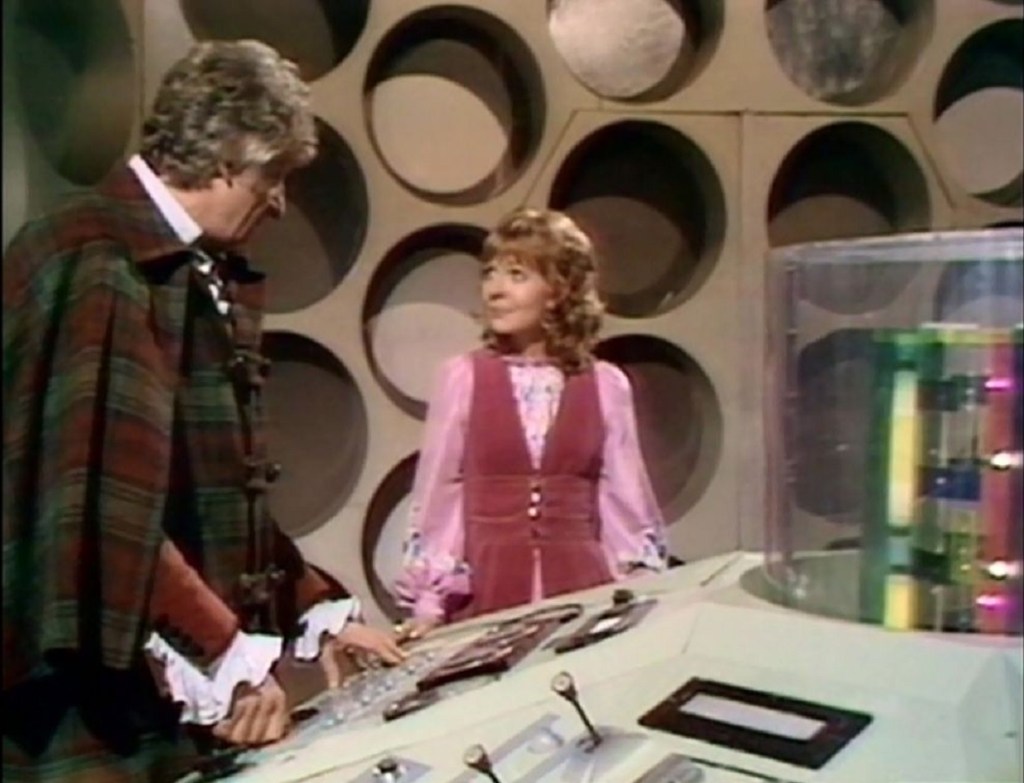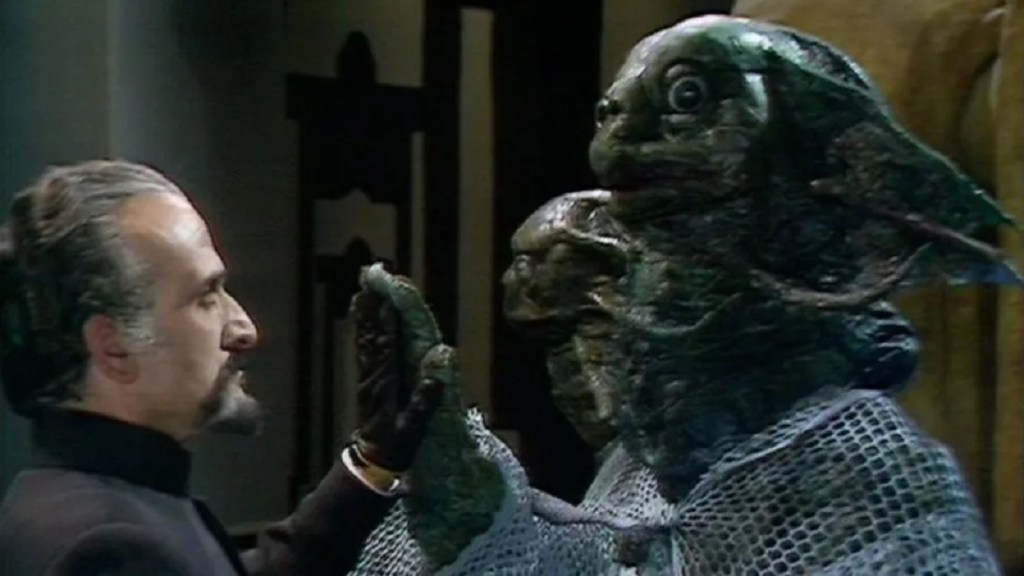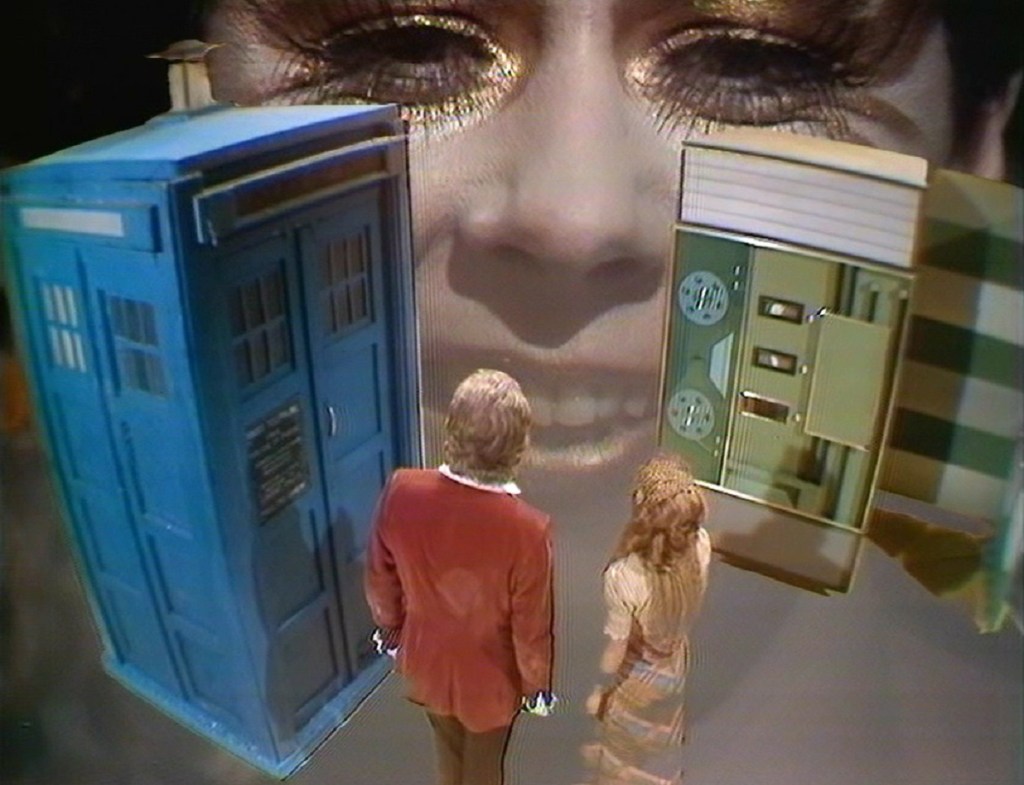Doctor Who‘s dynamic frilly-shirted leap into the exciting new world of colour had proved a resounding success so far; possible not quite on the same Beatle-threatening level as the initial outbreak of ‘Dalekmania’ – which you can find much more about here incidentally – but arguably in an entirely different sense it was more popular than it had ever been, and with no disrespect towards the rest of the brilliantly-matched ensemble cast and the confident and inventive approach of production team Terrance Dicks and Barry Letts, this was almost entirely down to one individual. Jon Pertwee had famously been advised to play the role as ‘himself’, and given that he was a wilfully extravagant and extroverted veteran of stage and screen with an assured wit, a way with a tall tale and a vivid and it is fair to say highly individual sense of style, it could be argued that he brought an entirely new quality to the role. Pertwee also established and visibly enjoyed a rapport with the general public that neither William Hartnell nor Patrick Troughton had nor wanted to have; he may always have gone out of his way to credit his colleagues both behind and in front of the camera, but as far as the viewing audience were concerned, Jon Pertwee was Doctor Who.
That credit he was always keen to apportion is crucial, however, and Pertwee had both literally and figuratively taken the lead in a series of adventures that had proved sufficiently intelligent, sophisticated and securely rooted against a backdrop of then-current everyday concerns to somehow persuade everyone to look past all of the rubber walls and cardboard monsters and enjoy Doctor Who for how good it was rather than how easy it was to make not very good jokes about the production values. More importantly, all of this had cemented Doctor Who as a vital and frequently namechecked cornerstone of a rock-solid ratings-conquering BBC1 Saturday Night schedule that is still widely held up as something that all broadcasters should be aspiring towards to this day.
The problem with this kind of momentum, however, is that it can sometimes be challenging to maintain. Series Nine of Doctor Who kicked off with the much-publicised and hugely anticipated return of The Daleks – a whole five years after they had last been seen on screen – in a quirky time-travel past-changing logic trap of a fast-paced story with plenty of loud blasts and outdoor Exterminating action, closely followed by a wry satire of the debate over the UK’s bid to join the European Economic Community cunningly disguised as a quasi-medieval take on an Agatha Christie thriller, and the muggy beachfront emergence of some sub-aquatic Silurians in the atypically grim surroundings of a maximum security prison, and then two very long stories that were apparently still being written several months after they had already completed production. Doctor Who‘s phenomenal popularity was enough to sustain it over those long weeks of blokes in uniforms forgetting what rank they were and a sort of chrono-bloodthirsty bird thing in a Roman helmet turning out to actually be some woman’s glittery eyes that were quite nice to everyone after all or something, but was this all a sign of trouble ahead – and if so, why didn’t Boaz and Shura warn U.N.I.T. about it? Or did they? Well, you may or may not find the answers here, but you can find a lot more about Doctor Who past and present in Can’t Help Thinking About Me, available in paperback here or from the Kindle Store here.
Was Day Of The Daleks Deliberately ‘Unspooky’?
Doctor Who‘s eighth series in 1971- as you can read much more about here – famously concluded with The Daemons, a story much beloved of the cast and crew in which the modish tension between science and superstition raged in a manner that still took care to leave for the latter, even when presented with definitive remote control car horn-honking proof of the latter, with sufficiently convincing flair for more than one viewer to apparently believe that the BBC had genuinely blown up an actual church in the name of budget-stretching sci-fi thrills. This approach was, it is reasonable to suggest, broadly in keeping with the tone that Doctor Who had more or less largely been adopting ever since the big colour relaunch in 1970, and indeed broadly in step with a wider tendency at the time towards presenting folk horror and supernatural encounters as mainstream entertainment; a phenomenon which incidentally you can hear much more about in Looks Unfamiliar here. In 1972, however, Day Of The Daleks opens with an immediate dismissal of rumours of phantoms haunting a mansion house as hokey conclusion-jumping codswallop, summarily disproved with cold hard scientific evidence that the supposed apparitions are in fact not especially covert ‘secret’ interlopers from the future out to alter the past with not a single thought for the implications of the Blinovitch Limitation Effect, and are never identified or discussed as potential employees of Rentaghost Enterprises again. Even in the same year as of Monty Python’s ‘Thirty Two Points Of Worry’ memo, this is scarcely likely to have been brought about as a consequence of ‘concerns’ either internal or external, yet even so the distinction is both sharp and marked and the remainder of the series confines itself very much to more grounded and realistic concerns -well, apart from The Time Monster – so was it a deliberate creative decision intended to help matters move on and move forward, just as introducing The Master and then scaling back his frequency of appearance for this run very much had been? It’s difficult to say for certain, and not even Terrance Dicks seems t0 have made too many puns about ending up doing paperwork about stories about paperwork to fall back on, but it wasn’t the only potential artistic handbrake turn at the start of that story…
Strange Things Are Afoot At The Circle Story ‘KKK’
Back in 1970, The Ambassadors Of Death opened with an amusing scene in which while tinkering with the newly-deactivated TARDIS console, The Doctor repeatedly sent U.N.I.T. Scientific Advisor Dr. Elizabeth Shaw and then himself roughly seven seconds into the future, followed by a fairly rational explanation for the benefit of the viewers which was then met with a comically sceptical look from a time-and-space savvy Liz. Two years later, Day Of The Daleks opened with a decided more overplayed and decidedly less comically askance scene in which while tinkering with the still-deactivated TARDIS console, The Doctor and Jo met themselves coming back from the future at the conclusion of the story – it does make sense when you watch it, honest – with some very stilted dialogue about ‘what are you doing here?’ – ‘well I’m not here’, explained away with a line about time being ‘a very complicated thing’ where ‘the oddest things start happening’ when you tamper with it. Whether intended as such or not, this really does come across as an attempt to disassociate the clever clogs scientist with her somewhat harder of thinking replacement brought in for the benefit of ‘the viewers’ too far, and arguably sits quite badly alongside the excellent qualities brought to Jo’s character elsewhere. Or maybe you just shouldn’t try doing the same joke twice in such close proximity. It’d be a bit like giving two entirely separate explanations for the destruction of Atlantis within twelve months of each other. Incidentally, before this particular entry generates an avalanche of furious comments on forums, it really does need to be pointed out that ‘KKK’ was the production code of Day Of The Daleks and not a reference to anything else that has more prominently deployed the same initials to less palatable ends, and “Strange things are afoot at the Circle K” is a line in a very similar scene from Bill And Ted’s Excellent Adventure. Yes way, Ted. Honestly, haven’t you lot got anything more important to worry about? It’s not like any of the surrounding stories featured a costume bordering so closely on the inadvertently obscene that the director refused to work with it or anything…
You’re The Green Alpha Centauri With The No-Pronged Cloak
When he wasn’t busy explaining that the appeal of The Daleks was apparently down to the fact that youngsters could imagine themselves climbing inside one and giving parents, teachers or ‘bully’ a quick exterminating blast – as regularly deployed and as downright baffling as Jon Pertwee’s insistence that nothing was scarier than coming home to find a Yeti, whom of course he never met on screen, availing itself of your en suite facilities which apparently for some never clarified reason was all the more terrifying if it specifically took place in Tooting Bec – Terrance Dicks was also much given to asserting that ‘the colour of monsters is green’. Even though a cursory glance in the direction of such utterly obscure and completely forgotten adversaries as The Cybermen should have been enough to reposition this as a generalism that belongs alongside megagalactic scarves and cardboard walls, he appears to have nonetheless very much put this to the test in European Economic Community satire disguised as a medieval rhino-bear thing ghost story that wasn’t slash political thriller in space The Curse Of Peladon, in which Galactic Federation representing representatives bad guys turned good guys Ice Warrior and Ice Lord Ssorg and Izlyr, wittering bipedal giant eye Alpha Centauri and snarky spidery reptile thing inside a giant mobile tumble drier Arcturus were all rendered in such a livid shade of green that they were at risk of changing the colour of Jon Pertwee’s very much not green smoking jacket by osmosis. Added to that, large expanses of the sets and scenery are of a suspiciously viridescent hue, and while they at least have made the effort in having yellow-ish tubes of fluid pumping about Arcturus’ person, they are it has to be a said a suspiciously chartreuse-resembling shade of yellow. Barry Letts might well have been keen to explore ‘green’ issues in the show, but this really was a bit much. Then on top of all that, Alpha Centauri went on to add a much-needed dash of green to a certain black and white-toned show that we are honestly best not dwelling on. Seriously. Maybe we need a bit of pink to literally lighten the mood…
“WOOP weeeeeb Wuh Wah-wur, weh woob weeb woh-waaaaaab weeb”
While under supposed lock and key in a military fort in The Sea Devils, The Master famously finds himself entranced by an episode of Clangers – and not ‘The Clangers’ like you and The Marshal Of Solos thought – and is sufficiently inspired to make a half-hearted attempt at something that could be said to vaguely approximate whistling but won’t be winning him the lead role in any putative remake of Twisted Nerve. There is even a vague suggestion that he may actually believe them to be a real interplanetary species, although if this is the case then sadly we never got to see whatever malevolent intergalactic chicanery he was working up with Mungo, Chippy Minton, Pashana Bedhi and Joe whose parents ran a transport cafe. The episode that he was so taken with was The Rock Collector, in which an astronaut visits The Clangers’ planet in the hope of retrieving rock samples but only ends up being pelted with Blue String Pudding, and leaving all smug lower-case winking emoji interjections about ‘U.N.I.T. Dating’ in the green recycling bin where they belong, The Master would have almost certainly been watching The Rock Collector on its first broadcast on Sunday 25th April 1971. Assuming that he would not have had access to the channel-changing controls out of concern that he might have used them for some indeterminate form of nefarious shenanigans, The Master would doubtless have spent the day watching BBC1’s programming for farmers, non-English speaking communities, amateur tennis players, the religiously observant and, erm, anyone thinking about buying a computer, and later on he could have taken time out from working on that machine he intended to use to trap them all together for a glance at Apparitions, a documentary in which Robert Robinson strove to determine whether religious visions were a real phenomenon or just a load of nish, tussock, flimp and fivepence; but then you notice what was on immediately after The Rock Collector and, yes, moving very rapidly on. Still, he could have always turned over to Radio 1 for… oh right, yes, well. To think we were all focusing all of our concern on a renegade Time Lord with a saturnine countenance whose only transgression was thinking up utterly implausible schemes for domination of nothing in particular and then explaining exactly what he planned to do to the very people who could stop him. Although The Clangers were always a bit too savvy to have fallen for his machinations, as you can find out in a chat about their little-seen Election Special here. Anyway, speaking of what was on the radio in 1972…
“That Was My Favourite DJ!”
Night Ride, Radio 1’s open-ended late-night slot for experimental music and provocative discourse, actually began as a more sedate keep on truckin’ kind of affair with the station’s launch in September 1967, but by early the following year it had evolved into a far less tameable assortment of poetry, world music and general musing on the sort of issues that weren’t exactly receiving a regular airing on European Pop Jury. Even given its obscure and out of the way timeslot, controversy and eventually political interference soon followed and the BBC quickly gave in to pressure from those who did not consider it appropriate for John and Yoko to be allowed to question why “they talk about Vietnam but they don’t talk about ‘we ate ham'” at one in the morning to an audience of furtively revising students and insomniac yippies, and by the following year it had reverted to a straight up music and arts slot, albeit one allowing jazz combos and folk singers to jam away into the early hours and beyond. Having long been simultaneously broadcast on a late night-deficient Radio 2, Night Ride switched to that station alone in April 1970, affording regular outings to the likes of Bobby Lamb And The Keymen, The Tony King Sound, Pete Winslow And His King Size Brass and other funky synth-toting BBC Records And Tapes-friendly outfits who you can read more about in Top Of The Box Vol. 2 here if you’re interested. Presumably this was why Jo was so keen to catch Night Ride in The Sea Devils, but on fiddling with the dial The Doctor finds only director Michael Briant unconvincingly babbling something about having a ‘wonderful batch of discs’ for ‘early birds’. If that was Jo’s favourite DJ, then she really did need to get out more. Or stay in more. However that works exactly. John Dunn was doing Breakfast Special on Radio 2! Mind you, this is far from the only hint that we get about Jo’s night-time proclivities…
Where Were Mike And Jo Off To?
Give or take the odd high level Peladonian church versus state disagreement followed by hapless Grand Council head Torbis being savaged by a conveniently unseen Aggedor, The Curse Of Peladon opens with a glammed-up Jo, resplendent in a Top Of The Pops audience-friendly burgundy waistcoat and pink blouse with flared sleeves ensemble, being waylaid by The Doctor – himself apparently dressed up as The McWomble – with the promise of a quick spin in a sort of slightly covertly operational Tardis for an interplanetary jaunt that has not been in any way deceptively planned and permitted by The Time Lords honest. A degree of arm-twisting has had to be deployed here however, for as Jo puts it herself, she is sharp dressed in the heighth of fashion in anticipation of a night on the town with Captain Mike Yates. Where they are actually headed for is never specified, and given Mike’s frequently stated preference for the less sophisticated menu options of military cuisine it hardly seems likely that they would be headed for an expensive and strictly dress-coded restaurant serving that fancy ‘foreign’ muck. If they’d had a trip to the cinema in mind then they could have gone to see surprisingly non-controversial teen pregnancy drama To Find A Man, down at heel Michael Caine vs. Elizabeth Taylor divorcey melodrama X Y & Zee, Kris Kristofferson country’n’drug dealin’ bleak social satire Cisco Pike or John Wayne’s somewhat self-explanatory The Cowboys, none of which would entirely have set a suitable tone for a wild carefree night on the tiles. If they fancied heading off into the West End instead then they could have caught David Essex, Julie Covington, Jeremy Irons and TV’s Frank Weisel from Yes, Minister Neil Fitzwiliam in the inaugural staging of pseudo-psychedelic biblical ba-ba-ba freakout Godspell at Wyndham’s Theatre, or Elaine Stritch heading a cast of visiting American actors better known for guest appearances in series that were all called things like Police Cop in Her Majesty’s Theatre’s unveiling of Stephen Sondheim’s latest wry social sendup Company. Assuming that The Inferno – more about that here if you’ve never heard of Swinging London’s most hip and happening nightspot – had weathered the advent of prog and Kitty and company were cueing up Trojan Records b-sides and Yes It’s You by Sweet Charles they could always have swung by for a bit of a frug, but otherwise it would appear that their options were somewhat limited. Though they could always have stuck on a certain newly-issued 45 and thrown a party right there…
Just For You, Well I’ve A Talent To Amuse…
In 1971, up-and-coming heavy rock superstars Deep Purple joined forces with EMI to launch their own record label, the moderately unimaginatively named Purple Records. Primarily intended as an outlet for their own group and solo efforts, Purple Records would also release singles and albums by amongst others actorly glam rockers Silverhead, prog-aligned West End star Yvonne Elliman, hilariously inappropriately named early metal outfit Elf, folk-rock duo Curtiss Maldoon – whose largely ignored 1971 album track Sepheryn would later with a slightly rejigged title become one of the biggest hit singles in pop history for a certain Madonna Louise Ciccone – and of course Jon Pertwee. Memorably described by Barry Letts in Doctor Who – A Celebration as ‘a middle-aged teenager whose musical tastes ran to heavy rock’, the whys and wherefores of Pertwee’s association with Deep Purple and his enthusiastic participation in what was to all intents a prog-skewed vocal version of the Doctor Who theme on Who is The Doctor have been endlessly speculated on, but nobody ever really pays very much attention to the single’s b-side. Apparently performed at least halfway in character, although it’s difficult to tell whether this is as The Doctor or as Jon Pertwee himself, Pure Mystery is a first-person lament by a sad old entertainer that nobody likes, regaling a presumably single figures audience with tales of his glory days stopping the show in summer seasons at ‘The Follies’ and The Hippodrome, turning entry-level card tricks into ‘a science of the mind’ and, erm, splitting the ‘basic’ atom live on stage before he was reduced to performing at birthday parties more or less as a way of passing the time. There’s no happy ending to this tale of reduced variety circumstances either; we leave him exactly where he is on a big echoey empty stage, fading rather heartbreakingly into the distance with only a characteristically ridiculous Pertwee ‘bom BOMMMM bommmm’ improvisation on the chorus melody to leaven the melancholy. There would of course be something of an ironic echo to this odd but likeable number later in his career as Pertwee’s ‘talent to amuse’ many different audiences on many different levels was never really utilised to its full advantage by a changing industry, and he was never quite called on to revisit his days of bareback horse riding in drag as ‘Madame Pertweeova’ in between guest roles on Virtual Murder and having his scrambler bike stolen by some scallies at the 1984 Liverpool International Garden Festival, but of course this was Jon Pertwee – a man for whom even personal and professional lows became stories to told – and it is difficult to deny that he nonetheless somehow managed to spin even this to his advantage. Mind you, Pure Mystery wasn’t always the b-side of Who Is The Doctor…
Was The Music In The Sea Devils Really That Weird?
Malcom Clarke’s angular electronic score from The Sea Devils – which would later bizarrely end up as the b-side to an early eighties reissue of Jon Pertwee’s rap about fingers moving to end mankind and metallic teeth beginning to grind – occupies its own notorious corner of Doctor Who history. It is, apparently, illegal to refer to it with any other descriptive phrase than ‘discordant jangles’ which reputedly put viewers off wearing shoes or something, led to the BBC Radiophonic Workshop being ‘banned’ from contributing to Doctor Who apart from all of the times that they did, and generally cultivated a public perception of Malcolm Clarke as being some sort of weird Kling Klang-adjacent hippy rather than the softly spoken librarian type he actually was. What is as incongruous about all of this as Walker’s apparent attempt to have a dance with a Sea Devil, however, is that it really doesn’t sound as atonal or atypical as its reputation would appear to suggest. There is certainly more extreme electronic ‘music’ in many of the sixties episodes, and for all his familiarity with a decent toe-tapping refrain, regular composer Dudley Simpson wasn’t above the odd bit of warbling oddness where it suited the story – and these screechy burbles really do suit The Sea Devils and it would arguably be a good deal less memorable without them. More importantly, the soundtrack to The Sea Devils was later repeatedly namechecked as an significant early influence by Orbital, and musically namechecked by 808 State on In Yer Face, which is more than can be said for that sort of upside down fanfare in The Mutants. Speaking of which…
“They Don’t Attack Us In The Tunnels”
The standard ‘witty’ observation made by pretty much everyone from A.J.P. Taylor to Little And Large that Doctor Who was just a load of running around in corridors remains as unfair as it is frustratingly persistent, but sometimes you have to just throw up your hands and reluctantly admit than in a handful of instances, it is not an observation without some degree of basis in reality. Take for example The Mutants, a well-intentioned box file of social commentary which fills in the inconveniently vast expanse between the opening pseudo-topical political scene-setting somehow involving the It’s… Man from Monty Python’s Flying Circus and Deputy Commissioner Butcher from The Goodies and the climactic psychedelic freakout that must have had more than a few viewers ignoring all exhortations not to adjust their newly-acquired colour set with a large amount of just that, very occasionally punctuated with someone urging everyone to stop, exclaiming ‘Listen!’, and then heading off in entirely the opposite direction. So circular and repetitive is this and indeed so vast is that expanse that it is honestly difficult to remember exactly how many episodes there are in The Mutants, let alone where you are up to in it, with many a hapless viewer expecting it to be out of the way and done with in four episodes only to discover that there are actually six. As if to add insult to injury, it is then followed by a story where nobody has any idea of how many episodes long it is for entirely different reasons…
They Like Big Boobs And They Cannot Lie (Brackets Underwater)
From The Doctor’s opening nightmare about some columns sort of not falling over to the closing ‘hilarity’ about Sergeant Benton dressed as an adult-sized baby, The Time Monster is six episodes of sheer preposterousness and doesn’t it know it. An unashamed flight of wink to the camera nonsense about The Master trying to bring back ancient time-scoffing entity Kronos The Kronivore for reasons even he doesn’t seem to be fully sure of, which also somehow apparently involves the destruction of Atlantis in an entirely different manner to how Azal – and who’s going to argue with him – recalled it in The Daemons less than twelve months previously, rather than go down the usual literal route of filling up the story length with a lot of running around in corridors The Time Monster elects to nudge itself towards the allotted running time with all manner of visually nonsensical babble ranging from two scientists doing a little dance – an actual dance, not like Walker and the would-be hot-hoofing Sea Devil – and at one point actually going into slow motion for a very very very long time indeed. In a cunning moment of narrative subterfuge, however, the production team managed to distract the audience en masse sufficiently to avoid them actually noticing any of this courtesy of the really quite startling neckline bestowed on Ingrid Pitt as Atlantean monarch Queen Galilea. Well-known for her not altogether dissimilar appearances in big screen and indeed big scream horror movies, Ingrid was one of apparently about twelve actresses at the time who had independently been adjudged by a never-identified panel of dubious gentlemen as ‘The Countess Of Cleavage’, but even allowing for that her neckline must have at the very least raised eyebrows at the BBC in 1972. The entire cast, Katy Manning included, deliver their dialogue with an unwavering line of vision that may as well have seen her discard her own copy of the script and reply to every other line with ‘I’m up here’, while many years later, a generation of adolescent boys would discover that their copy of Doctor Who – 25 Glorious Years mysteriously fell open at that exact page. No I did not know automatically and with unswerving certainty that it was page one hundred and fifty. What do you take me for?
Anyway, join us again next time for Patrick Troughton’s Carnival Of Light, a fad for ‘Breakfast Beef’ and why The Master was so keen to get his hands on Richard Herring’s Roulette Wheel…
Buy A Book!
You can find an expanded version of It’s Still A Police Box, Why Hasn’t It Changed? looking at the entire sixties run of Doctor Who in Can’t Help Thinking About Me, a collection of columns and features with a personal twist. Can’t Help Thinking About Me is available in paperback here or from the Kindle Store here.
Alternately, if you’re just feeling generous, you can buy me a coffee here. Actually, just funnel it directly into those slow-motion bits in The Time Monster. They may be beyond help but who knows.
Further Reading
You can find further musings on the 1971 series of Doctor Who in It’s Still A Police Box, Why Hasn’t it Changed? here.
Further Listening
You can hear much more about The Clangers – and their little-seen Election Special – in my appearance on The Zeitgeist Tapes here.
© Tim Worthington.
Please don’t copy this only with more italics and exclamation marks.
